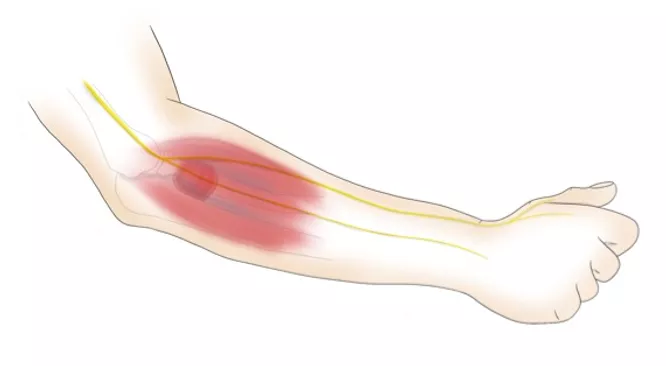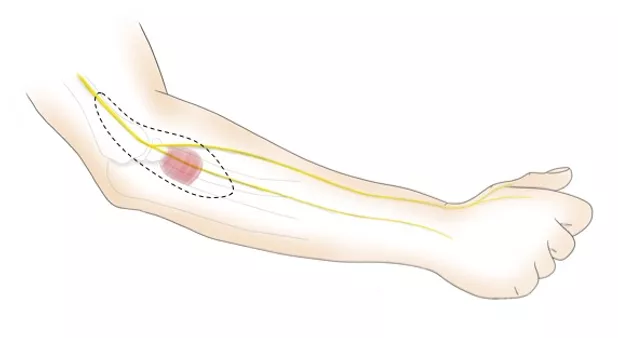Tennis elbow, or lateral epicondylitis, is a condition that causes the tendons around your elbows to swell and cause pain. You may experience pain at the area where the tendons of your forearm muscle connects to a bony bump outside the elbow. The pain can sometimes spread to your forearm and wrist.
Tennis elbow is usually caused by the overuse of forearm muscles and repetitive motions, such as gripping and swinging a tennis racket. Over time, these repetitive motions strain your forearm muscles and places stress on your tendons, resulting in tiny tears developing near the bony bump on the outside of your elbow.
Even though playing tennis contributes to tennis elbow, other activities that require repeated arm motions could also increase your risk of developing the condition, such as:
- Playing squash
- Painting
- Knitting
- Plumbing
- Repetitive computer mouse use

Tennis elbow typically affects the muscles over the outer (lateral) aspect of the elbow. Muscle inflammation causes discomfort during movement and load bearing.

Nerve compression is an uncommon cause of elbow pain that is suspected when tennis elbow fails to respond to standard treatment.
Source: handartisans.com
What are the symptoms of tennis elbow?
The main symptom of tennis elbow is feeling pain at the bony point on the outside of your elbow. The pain may sometimes radiate to your forearm and wrist. You may also experience pain when using your hands, or performing certain activities, such as:
- Lifting an object
- Gripping an object or making a fist
- Opening a door
- Shaking hands
- Having difficulty in extending your affected arm
Elbow joint arthritis can also give rise to similar symptoms. It is important to differentiate this from muscle inflammation in patients with a history of elbow trauma, or patients who are older.
Other uncommon causes that may result in similar pain symptoms include tumours such as ganglion, or radial nerve compression. These medical conditions often do not respond to typical tennis elbow treatments that involve the use of a counterforce band, ergonomic adaptions, or injections.
Make an appointment to consult an orthopaedic specialist if you experience symptoms of tennis elbow and wish to have them confirmed.
What treatments are available for tennis elbow?
Counterforce band
If you are found to have inflamed muscle bellies, a counterforce band may be applied over the affected area to provide external compression and aid muscle recovery, similar to athletic compression stockings.
Activity modification, which involves changing common activities of daily living, will also help to improve efficiency and ergonomics. Patients will be advised to avoid activities that worsen the pain from tennis elbow to protect the tendon from further strain.
Steroid or plasma injection
If the above treatment is unsuccessful, steroid or plasma injection may be used to reduce inflammation of the muscles. Steroid reduces inflammation whereas plasma augments the recovery process.
Both treatments are equally effective at providing pain relief. Long-term outcomes will vary between patients based on their level of activity and severity of inflammation. For example, an athlete will require a vastly different treatment approach compared to a sedentary office worker.
Other treatments
Other treatments for tennis elbow include shock wave therapy, radiofrequency coblation (controlled purposeful application of thermal energy), or muscle slide procedures.
Surgery for tennis elbow is rarely required and treatments are tailored based on clinical evaluation, guided by imaging findings.
Physiotherapy
Physiotherapy may be recommended to prevent your tennis elbow from recurring. The physiotherapist will teach you how to stretch and strengthen your forearm muscles, as well as reduce stiffness and improve flexibility.
Most patients may be able to return to activities that require the use of the affected elbow within four to six months.
How should I sleep if I have a tennis elbow?
You should sleep on your back and relax your arms while you keep them straight beside your body. You can also place your arms on pillows to avoid straining your elbow. Sleeping on your back also helps to keep your spine straight and helps you to get a better rest.
What exercises should I avoid if I have a tennis elbow?
Exercises that require repetitive lifting or repetitive movement of your elbow, such as racket sports, basketball, volleyball, chin-ups, push-ups, or dumbbell curls, should be avoided. Such exercises add stress to your elbow and forearm, which may aggravate your existing injury.
Make an appointment
Make an appointment to consult an orthopaedic specialist. Select "Specialist Appointment". Under Specialist Appointment Details, select "Orthopaedic Surgery" or "Pain Management".
Make an enquiry. We will get back to you within 2 working days. You can reach us at 6311 2310.